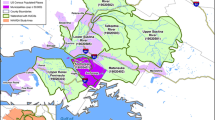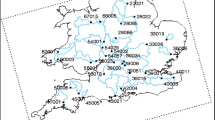Abstract
A deterministic monthly runoff model (MINRUN96)was applied to watersheds with substantially differentclimates. One watershed is in the north-central U.S.(Minnesota) and is heavily timbered. The other is inthe south-central U.S. (Oklahoma) and is mainlycovered with pastures and agricultural crops. Runoffwas simulated for past historical climate and twoprojected 2 × CO2 climate scenarios. The output ofGeneral Circulation Models (GCMs) was used to specifythe two 2 × CO2 climate scenarios. One GCM is theGoddard Institute of Space Studies (GISS) model andthe other is from the Canadian Center of ClimateModelling (CCC). In the northern watershed morerunoff is projected to occur in winter under a warmerclimate and less runoff in spring. About 80%increase in fall runoff and 20% decrease in soilmoisture in June and July is projected for thesouthern watershed. When runoff simulations for the2 × CO2 climate scenarios were compared to pastrunoff, it was apparent that the change in runoffdepended on both the season and the magnitude of theprecipitation change. An increase in springprecipitation caused a significant increase in directrunoff, whereas an increase in fall precipitationcaused only a slight increase in total runoff. Alsothe runoff-precipitation relationship in the warm andseasonally dry southern watershed is very differentfrom that in the temperate and humid climate of thenorth. Therefore, runoff responses to projectedclimate change are substantially different in the tworegions.
Similar content being viewed by others
References
Allen, P. B. and Naney, J. W.: 1991, Hydrology of the Little Washita River Watershed, Oklahoma; Data and Analysis, U.S. Department of Agriculture, Agricultural Research Service, Durant, OK, ARS-90.
Giorgi, F., Brodeur, C. S., and Bates, G. T.: 1994, ‘Regional Climate Change Scenarios over the United States Produced with a Nested Regional Climate Model’, J. Climate 7, 375–399.
Giorgi, F., Meehl, G. A., Kattenberg, A., Grassl, H., Mitchell, J. F. B., Stouffer, R. J., Tokioka, T., Weaver, A. J., and Wigley, T. M. L.: 1998, ‘Simulation of Regional Climate Change with Global Coupled Climate Models and Regional Modeling Techniques’, in Watson, R. T., Zinyowera, M. C., and Moss, R. H. (eds.), The Regional Impacts of Climate Change, Cambridge University Press, Cambridge, U.K.
Gleick, P. H.: 1987a, ‘The Development and Testing of a Water Balance Model for Climate Impacts Assessment: Modeling the Sacramento Basin’, Water Resour. Res. 23, 1049–1061.
Gleick, P. H.: 1987b, ‘Regional Hydrologic Consequences of Increases in Atmospheric CO2 and Other Trace Gases’, Clim. Change 10, 137–160.
Hansen, J., Russell, G., Rind, D., Stone, P., Lacis, A., Lebedeff, S., Ruedy, R., and Travis, L.: 1983, ‘Efficient Three-Dimensional Global Models for Climate Studies: Model I and II’, Mon. Wea. Rev. 111, 609–662.
Hostetler, S. W. and Giorgi, F.: 1995, ‘Effects of 2 _ CO2 Climate on Two Large Lake Systems: Pyramid Lake, Nevada, and Yellowstone Lake, Wyoming’, Global Planet. Change 10, 43–54.
Hughes, J. P. and Guttorp, P.: 1994, ‘A Class of Stochastic Models for Relating Synoptic Atmospheric Patterns to Regional Hydrologic Phenomena’, Water Resour. Res. 30, 1535–1546.
Lettenmaier, D. P. and Gan, T. Y.: 1990, ‘Hydrologic Sensitivity of the Sacramento-San Joaquin River Basin, California, to Global Warming’, Water Resour. Res. 26, 69–86. 104 OMID MOHSENI AND HEINZ G. STEFAN
McCabe Jr., G. J. and Ayers, M. A.: 1989, ‘Hydrologic Effects of Climate Change in the Delaware River Basin’, Water Resour. Bull. 25, 1231–1242.
McFarlane, N. A., Boer, G. J., Blanchet, J. P., and Lazare, M.: 1992, ‘The Canadian Climate Center Second-Generation General Circulation Model and its Equilibrium Climate’, J. Climate 5.
Mimikou, M., Kouvpoulos, Y., Cavadias, G., and Vayianos, N.: 1991, ‘Regional Hydrological Effects of Climate Change’, J. Hydrol. 123, 119–146.
Mohseni, O. and Stefan, H. G.: 1998, ‘A Monthly Streamflow Model’, Water Resour. Res. 34, 1287–1298.
National Research Council: 1982, Carbon Dioxide/Climate Review Panel. Carbon Dioxide and Climate: A Second Assessment, National Academy Press, Washington, D.C.
National Research Council: 1983, Changing Climate: Report of the Carbon Dioxide Assessment Committee, National Academy Press, Washington, D.C.
Newman, L. E., Baker, D. G., and Skaggs, R. H.: 1992, The Effects of Climate Variability and Greenhouse Effect-Scenarios on Minnesota's Water Resources, Technical Report No. 135, University of Minnesota, Department of Geography and Soil Sciences, Water Resources Research Center.
Rao, A. R. and Al Wagdany, A.: 1995, ‘Effects of Climate Change in the Wabash River Basin’, J. Irrigation Drainage Engng. 121, 207–215.
Russell, L. G., Miller, J. R., and Rind, D.: 1995, ‘A Coupled Atmosphere-Ocean Model for Transient Climate Change Studies’, Atmos.-Ocean 33, 683–730.
Schaake Jr., J. C.: 1990, ‘Climate Change’, inWaggoner, P. E. (ed.), Climate Change and U.S. Water Resources, Wiley, New York.
Shaw, E. M.: 1983, Hydrology in Practice, 2nd edn., Chapman and Hall, London.
Singh, P. and Kumar, N.: 1997, ‘Impact Assessment of Climate Change on the Hydrological Response of a Snow and a Glacier Melt Runoff Dominated Himalayan River’, J. Hydrol. 193, 316–350.
Sorooshian, S. and Gupta, V. K.: 1983, ‘Automatic Calibration of Conceptual Rainfall-Runoff Models: The Question of Parameter Observability and Uniqueness’, Water Resour. Res. 19: 260–268.
Thornthwaite C. W. and Mather, J. R.: 1955, ‘The Water Balance’, in Publications in Climatology Laboratory of Climatology, 8(1).
U.S. Army Corps of Engineers: 1956, Summary Report of the Snow Investigations: Snow Hydrology, Report, North Pacific Division, Portland, OR.
van Hylckama, T. E. A.: 1956, ‘The Water Balance of the Earth’, Publications in Climatology, Laboratory of Climatology, 9(2).
von Storch, H., Zorita, E., and Cubasch, U.: 1993, ‘Downscaling of Global Climate Change Estimates to Regional Scales: An Application to Iberian Rainfall in Wintertime’, J. Climate 6, 1161–1171.
Wilks, S. D.: 1992, ‘Adapting Stochastic Weather Generation Algorithms for Climate Change Studies’, Clim. Change 22, 67–84.
Xu, C. Y. and Halldin, S.: 1997, ‘The Effect of Climate Change on River Flow and Snow Cover in the NOPEX Area Simulated by a Simple Water Balance Model’, Nordic Hydrol. 28, 273–282.
Zorita, E., Hughes, J. P., Lettenmaier, D. P., and von Storch, H.: 1995, ‘Stochastic Characterization of Regional Patterns for Climate Model Diagnosis and Estimation of Local Precipitation’, J. Climate 8, 1023–1042. (Received 10 February 1999; in revised form 7 June 2000)
Author information
Authors and Affiliations
Rights and permissions
About this article
Cite this article
Mohseni, O., Stefan, H.G. Water Budgets of Two Watersheds in Different Climatic Zones under Projected Climate Warming. Climatic Change 49, 77–104 (2001). https://doi.org/10.1023/A:1010766906545
Issue Date:
DOI: https://doi.org/10.1023/A:1010766906545




